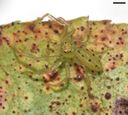Translucent Green Jumpers
Lyssomanes
Classification
- Phylum: Arthropoda
- Subphylum: Chelicerata
- Class: Arachnida
- Order: Araneae
- Infraorder: Araneomorphae
- Family: Salticidae
- Genus: Lyssomanes
Pronunciation
How to pronounce Lyssomanes: /ˌlɪsəˈmeɪniːz/
These audio files are automatically generated. While they are not always 100% accurate, they are a good starting point.
Images






Summary
Lyssomanes viridis, commonly known as the magnolia green jumper, is a small jumping spider found primarily on magnolia trees and other broad-leaved plants. It is recognized for its vibrant coloration, unique morphology, and jumping behavior.
Physical Characteristics
Small for a jumping spider, adult females measure 7-8 mm; adult males 5-6 mm. Pale, partially translucent green body with small fringe of scales that may be red, orange, yellow, or white on the head, framing the eyes. Features longer legs relative to the body and highly complex eyes, well-developed vision, and complex visual cognition behavior.
Identification Tips
Look for the small size, pale green coloration, and the distinctive fringe of colored scales on the head. Males are identifiable by brightly colored and large chelicerae.
Habitat
Prefers broad leaves of magnolia trees in warm, humid forests, but can also be found on oak, maple, pine, and other trees, as well as bushes in dryer climates.
Distribution
Widespread from Mexico to Argentina in the New World, observed particularly in the Southeastern U.S. (Texas, Louisiana, Alabama, etc.), Eastern Mexico, and as far south as Guatemala and as far west as Colorado.
Diet
Primarily preys on other species inhabiting plants, including mites, aphids, ants, and occasionally other spiders. Uses ambush tactics due to relatively short jump distance.
Life Cycle
Mating occurs in spring months (especially May). Females lay eggs (pale green, 25-70 per clutch) on the underside of leaves and guard them until they hatch. Sub-adults overwinter on trees and develop in early spring.
Reproduction
Eggs are laid on the underside of leaves, and females guard the eggs until they hatch. Males display visual and vibratory signals during mating.
Ecosystem Role
Acts as a predator of small herbivorous pests on plants, contributing to natural pest control.
Evolution
Thought to be one of the earliest-evolving genera of jumping spiders, representing a link between primitive spider morphologies and behaviors and the family Salticidae.
Tags
- jumping spider
- Lyssomanes
- Lyssomanes viridis
- magnolia green jumper
- arachnid